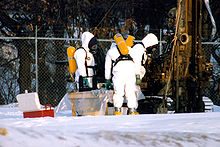Mangroves are an integral part of ecosystems.
Ecosystem management is a process that aims to conserve major ecological services and restore natural resources while meeting the socioeconomic, political, and cultural needs of current and future generations.
The principal objective of ecosystem management is the efficient maintenance and ethical use of natural resources.
It is a multifaceted and holistic approach which requires a significant
change in how the natural and human environments are identified.
Several approaches to effective ecosystem management engage
conservation efforts at both local and landscape levels and involve: adaptive management, natural resource management, strategic management, and command and control management.
Formulations
A variety of definitions exist: Robert T. Lackey
defined ecosystem management as "the application of ecological and
social information, options, and constraints to achieve desired social
benefits within a defined geographic area and over a specified period." F. Stuart Chapin
and coauthors define it as "the application of ecological science to
resource management to promote long-term sustainability of ecosystems
and the delivery of essential ecosystem goods and services,"
while Norman Christensen and coauthors defined it as "management driven
by explicit goals, executed by policies, protocols, and practices, and
made adaptable by monitoring and research based on our best
understanding of the ecological interactions and processes necessary to
sustain ecosystem structure and function."
Peter Brussard and colleagues defined it as "managing areas at various
scales in such a way that ecosystem services and biological resources
are preserved while appropriate human use and options for livelihood are
sustained".
The definitions of ecosystem management are typically vague. Several core principles define and bound the concept and provide operational meaning:
- ecosystem management reflects a stage in the continuing evolution of social values and priorities; it is neither a beginning nor an end;
- ecosystem management is place-based and the boundaries of the place must be clearly and formally defined;
- ecosystem management should maintain ecosystems in the appropriate condition to achieve desired social benefits;
- ecosystem management should take advantage of the ability of ecosystems to respond to a variety of natural and man-made stressors, but all ecosystems have limited ability to accommodate stressors and maintain a desired state;
- ecosystem management may or may not result in emphasis on biological diversity;
- the term sustainability, if used at all in ecosystem management, should be clearly defined—specifically, the time frame of concern, the benefits and costs of concern, and the relative priority of the benefits and costs; and
- scientific information is important for effective ecosystem management, but is only one element in a decision-making process that is fundamentally one of public and private choice.
A fundamental principle is the long-term sustainability of the production of goods and services by the ecosystem; "intergenerational sustainability [is] a precondition for management, not an afterthought".
It also requires clear goals with respect to future trajectories and
behaviors of the system being managed. Other important requirements
include a sound ecological understanding of the system, including
connectedness, ecological dynamics and the context in which the system
is embedded. An understanding of the role of humans as components of the
ecosystems and the use of adaptive management is also important. While ecosystem management can be used as part of a plan for wilderness conservation, it can also be used in intensively managed ecosystems.
As a concept of natural resource management,
ecosystem management remains both ambiguous and controversial, in part
because some of its formulations rest on policy and scientific
assertions that are contested.[9]
These assertions are important to understanding much of the conflict
surrounding ecosystem management. Professional natural resource
managers, typically operating from within government
bureaucracies and professional organizations, often mask debate over
controversial assertions by depicting ecosystem management as an
evolution of past management approaches.
History
Sustainable ecosystem management was used by large parts of populations thousands of years ago. The native
population in the territory of the USA before the arrival of the
Europeans, barely changed the ecosystems because it preferred adapting
to them rather than changing them.
Stakeholders
Stakeholders
are individuals or groups of people who are affected by environmental
decisions and actions, but they also may have power to influence the
outcomes of environmental decisions relating to ecosystem management.
The complex nature of decisions made in ecosystem management, from
local to international scales, requires stakeholder participation with a
diversity of knowledge, perceptions, and values of nature. Stakeholders will often have different interests in ecosystem services.
This means effective management of ecosystems requires a negotiation
process that develops mutual trust in issues of common interest with the
objective of creating mutually beneficial partnerships.
Adaptive management
Adaptive management is based on the concept that predicting future influences/disturbance to an ecosystem is limited and unclear. Therefore, the goal of adaptive management is to manage the ecosystem so it maintains the greatest amount of ecological integrity, but also to utilize management practices that have the ability to change based on new experience and insights.
Adaptive management aims to identify uncertainties in the management of an ecosystem while using hypothesis testing to further understand the system. In this regard, adaptive management encourages learning from the outcomes of previously implemented management strategies.
Ecosystem managers form hypotheses about the ecosystem and its
functionality and then implement different management techniques to test
the hypotheses.
The implemented techniques are then analyzed to evaluate any
regressions or improvements in functionality of the ecosystem caused by
the technique. Further analysis allows for modification of the technique until it successfully meets the ecological needs of the ecosystem. Thus, adaptive management serves as a “learning by doing” method for ecosystem management.
Adaptive management has had mixed success in the field of
ecosystem management, possibly because ecosystem managers may not be
equipped with the decision-making skills needed to undertake an adaptive
management methodology. Additionally, economic, social and political priorities can interfere with adaptive management decisions.
For this reason, adaptive management should be a social process as well
as scientific, focusing on institutional strategies while implementing
experimental management techniques.
Natural resource management
The term natural resource management is frequently used when dealing with a particular resource for human use rather than managing the whole ecosystem.
A main objective of natural resources management is the sustainability
for future generations, which appoints ecosystem managers to balance
natural resources exploitation and conservation over long-term
timeframe. The balanced relationship of each resource in an ecosystem is subject to change at different spatial and temporal scales.
Dimensions such as watersheds, soils, flora, and fauna need to be
considered individually and on a landscape level. A variety of natural
resources are utilized for food, medicine, energy and shelter.
The ecosystem management concept is based on the relationship
between sustainable resource maintenance and human demand for use of
natural resources. Therefore, socioeconomics factors significantly affect natural resource management.
The goal of a natural resource manager is to fulfill the demand for a
given resource without causing harm to the ecosystem, or jeopardizing
the future of the resource.
Partnerships between ecosystem managers, natural resource managers and
stakeholders should be encouraged in order to promote a more sustainable
use of limited natural resources.
Natural resource managers must initially measure the overall integrity
of the ecosystem they are involved in. If the ecosystem supporting
resources is healthy, managers can decide on the ideal amount of
resource extraction, while leaving enough to allow the resource to
replenish itself for subsequent harvests.
Historically, some natural resources have experienced limited human
disturbance and therefore have been able to subsist naturally .
However, some ecosystems such as forests,
which typically provide considerable timber resources; have sometimes
undergone successful reforestation processes and consequently have
accommodated the needs of future generations. A successfully managed
resource will provide for current demand while leaving enough to
repopulate and provide for future demand.
Human populations have been increasing rapidly, introducing new stressors to ecosystems, such as climate change and influxes of invasive species. As a result, the demand for natural resources is unpredictable. Although ecosystem changes may occur gradually, the cumulative changes can have negative effects for humans and wildlife. Geographic Information Systems (GIS) and Remote Sensing
Applications can be used to monitor and evaluate natural resources by
mapping them in local and global scales. These tools will continue to be
highly beneficial in natural resources management.
Strategic management
Strategic management
encourages the establishment of goals that will benefit the ecosystem
while keeping socioeconomic and politically relevant issues in mind.
Strategic management differs from other types of ecosystem management
because it keeps stakeholders involved and relies on their input to
develop the best management strategy for an ecosystem. Similarly to
other modes of ecosystem management, this method places a high level of
importance on evaluating and reviewing any changes, progress, or
negative impacts and prioritizes flexibility in adapting management
protocols as a result of new information.
Landscape level conservation
Landscape level conservation is a method that considers wildlife needs at a broader landscape level scale when implementing conservation initiatives.
This approach to ecosystem management involves the consideration of
broad scale interconnected ecological systems that acknowledges the
whole scope of an environmental problem.
In a human-dominated world, weighing the landscape requirements of
wildlife versus the needs of humans is a complicated matter.
Landscape level conservation is carried out in a number of ways. A wildlife corridor,
for example, is a connection between otherwise isolated habitat patches
that are proposed as a solution to habitat fragmentation.
In some landscape level conservation approaches, a key species
vulnerable to landscape alteration is identified and its habitat
requirements are assessed in order to identify the best option for
protecting their ecosystem.
However, lining up the habitat requirements of numerous species in an
ecosystem can be difficult, which is why more comprehensive approaches
to further understand these variations have been considered in landscape
level conservation.
Human-induced environmental degradation is an increasing problem globally, which is why landscape level ecology plays an important role in ecosystem management.
Traditional conservation methods targeted at individual species need
to be modified to include the maintenance of wildlife habitats through
consideration of both human-induced and natural environmental factors.
Command and control management
Command
and control management utilizes a linear problem solving approach where
a perceived problem is solved through controlling devices such as laws,
threats, contracts and/or agreements. This top-down
approach is used across many disciplines and works best with problems
that are relatively simple, well-defined and work in terms of cause and
effect.
The application of command and control management has often attempted
to control nature in order to improve product extractions, establish
predictability and reduce threats. Some obvious examples of command and control management actions include: the use of herbicides and pesticides
to safeguard crops in order to harvest more products; the culling of
predators in order to obtain larger, more reliable game species; and
the safeguarding of timber supply, by suppressing forest fires.
Attempts at command and control management often backfire (a
literal problem in forests that have been ‘protected’ from fire by
humans and are subsequently full of fuel build-up) in ecosystems due to
their inherent complexities. Consequently, there has been a transition
away from command and control management due to many undesirable
outcomes and a stronger focus has been placed on more holistic
approaches that focus on adaptive management and finding solutions
through partnerships.







